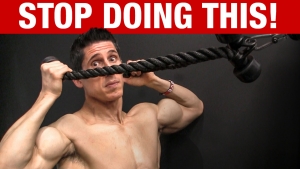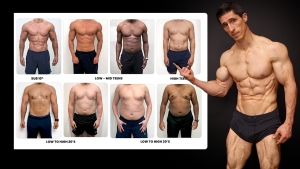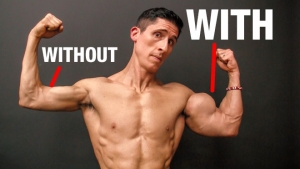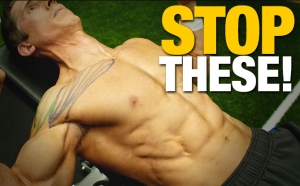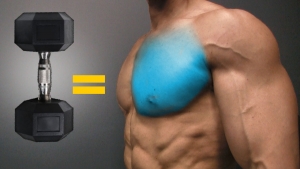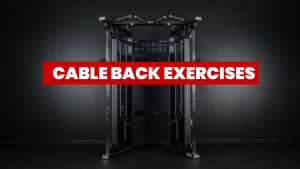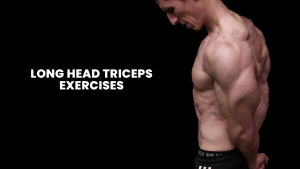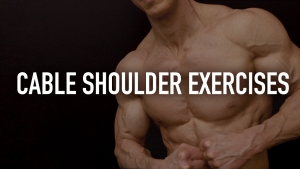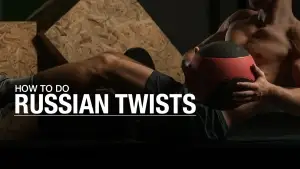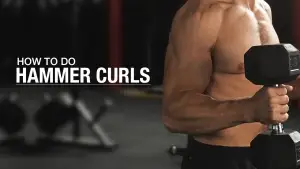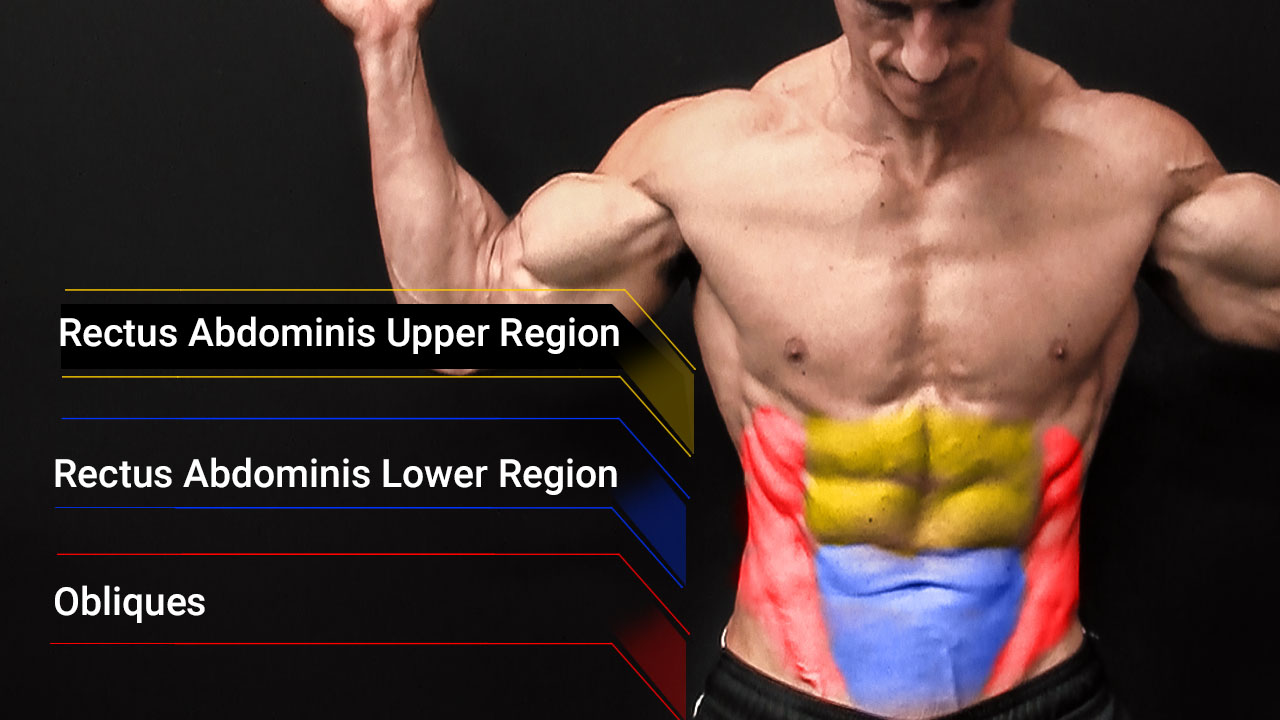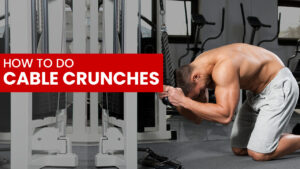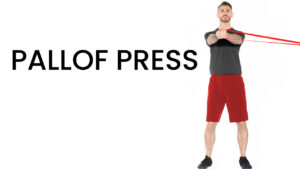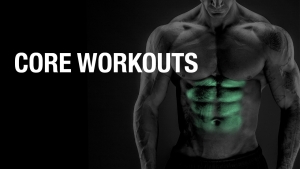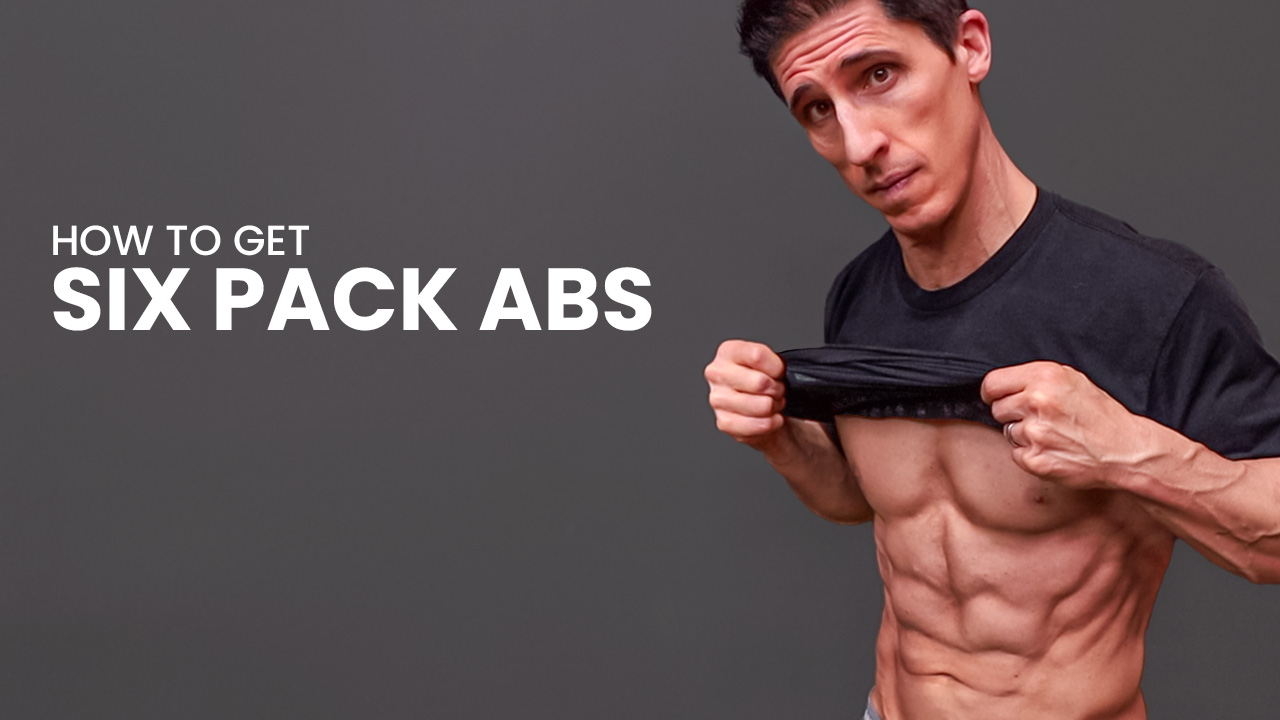
WHAT IT REALLY TAKES TO GET A SIX PACK
And yet, when you look at yourself in the mirror, you still don’t see those six-pack abs you’re chasing.
Don’t be too hard on yourself.
Six pack abs are eluding you not because you’re lazy or unmotivated. It’s because you’re missing the two most important pieces of the puzzle:
- The correct ab exercise progression
- A proven strategy to drop body fat percentages
In this guide, I’ll show you exactly how to train smarter for six pack abs, not just harder.
You’ll learn core workouts based on a surefire progression as well as a no-nonsense nutrition approach to get leaner, stronger, and finally carve out the abs you’ve been working for.
ANATOMY OF A SIX PACK
If you want six-pack abs, you better know what muscles you’re trying to train.
Most people hit a few random abdominal exercises, burn out their rectus abdominis muscles, and totally ignore the other muscle groups. Then they wonder why they’re not seeing visible six-packs.
To build a strong core that not only looks good but performs under pressure during compound movements, core workouts, and real-life functional activities, you need to train all layers of the abdominal muscle wall, not just the surface-level showpiece.
Knowing what each muscle does also helps you lock in a strong mind-to-muscle connection, which is essential for firing the right muscles at the right time.
If you can’t feel a muscle working, chances are you’re not training it effectively and that’s the fast lane to wasted training sessions and stalled progress.
Here’s a breakdown of the muscles you’ll need to target to build a set of six-pack abs.
RECTUS ABDOMINIS


This is the muscle everyone’s talking about when they say they want six-pack abs. It runs vertically from your sternum to your pubic bone, right down the front of your torso.
Its main job?
Spinal flexion or bending your spine forward during movements like Crunches, Knee Tucks, and Hanging Leg Raises.
But if you’re only training this one muscle since it’s front and center, you’re missing the bigger picture.
You’ll also need to hit these other muscles.
EXTERNAL OBLIQUES

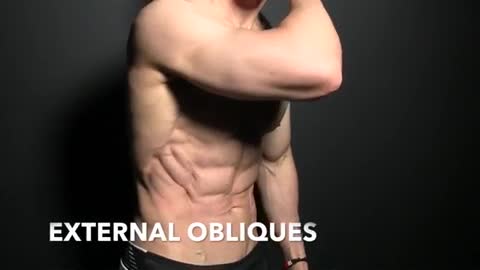
These lie on either side of your torso, running diagonally from your lower ribs to your pelvis.
They’re responsible for rotating and bending the torso, and they help control side-to-side movement and trunk stability.
You’ll feel them fire during dynamic exercises like Twisting Knee Mountain Climbers, Twisting Planks, and Rotational Crunches.
INTERNAL OBLIQUES


Tucked just beneath the external obliques, these muscles run in the opposite direction from your pelvis up toward the ribs.
They work together with the external obliques to handle rotation, side bending, and core stabilization.
The internal obliques are key for protecting your spine during compound lifts, transferring power through your posterior chain, and building core endurance that lasts through every training session.
You don’t see them directly, but you’ll feel the difference when they’re strong.
TRANSVERSE ABDOMINIS

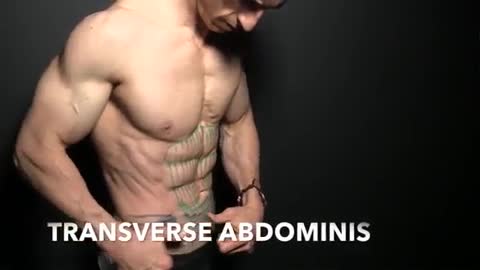
This is your deepest core muscle, wrapping horizontally around your midsection like a built-in weight belt.
Think of it as your body’s natural brace. It compresses the abdomen, stabilizes the spine, and protects you during heavy lifts or fast-paced core workouts.
When trained properly with moves like Vacuum Holds, the transverse abdominis tightens the waistline, supports a functional core, and enhances both strength and postural control.
You can’t get true core strength without it.
SERRATUS ANTERIOR

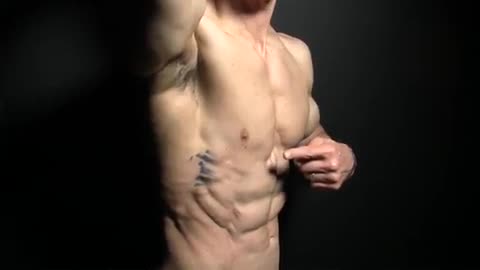
While not technically an ab muscle, the serratus anterior finishes the look of a fully developed core and keeps your upper body structurally sound.
Often overlooked but impossible to miss on a shredded physique, the muscle sits just below your chest, along your rib cage, and over the top of your external obliques.
It’s what gives that “razor cut” look between your ribs and abs. It’s the kind of definition you see on the abs of stars including Hugh Jackman in the Deadpool & Wolverine movie.
Functionally, it stabilizes the scapula and supports overhead movements.
Train it with extended Push-Up Position Holds, something I like to call the Push-Up Plus.
SIX PACK PROGRESSION
Most people hit their abs with a random mix of core exercises, hoping to improve aesthetic appearances without understanding how their abdominal muscles work.
That’s a recipe for wasted effort, slow progress, and a whole lot of frustration.
If you want visible six-pack abs, improved core musculature, and a truly functional core, you need a better core training strategy.
One that prioritizes your energy, hits your entire core, and gets you the maximum benefits from every rep.
But it’s not just about choosing the right exercises. You also need to put them in the most effective order.
That’s where my Six-Pack Progression comes in.
As a personal trainer and strength coach, I’ve used this progression with clients, athletes, and anyone chasing real ab-related goals.
It trains the abs in the order that gives you the most bang for your buck, starting with the hardest, most demanding movements while your body is fresh.
Here’s the sequence that gets it done:
LOWER ABS
We start with lower ab and bottom-up movements, like Hanging Knee Raises and Prone Knee Tucks.
These challenge the lower part of your rectus abdominis and hip flexors through a greater range of motion while supporting the external weight of your legs.
That means more energy expenditure, more muscle tissue activation, and more impact on you
Since these are on the difficult side, these exercises should be your first priority before fatigue sets in.
BOTTOM-UP MOVEMENTS
Now we move into bottom-up exercises. A great example exercise would be Twisting Pistons.
These movements continue to challenge your lower abs and target the abdominal muscle wall from a bottom-up direction of movement.
These movements use gravity and your own muscle mass to create resistance, promoting greater abdominal development while keeping your rest periods tight.
OBLIQUES
Next, we train the internal and external obliques, the twisting, rotating powerhouses along the sides of your torso.
Exercises like Rotational Planks, Side V-Ups, and Mountain Climbers with Rotation are key for shaping the waist and improving rotational control.
Obliques are essential for building a functional core and reducing injury during activity, especially during compound movements and functional tasks like throwing or lifting.
MID-RANGE
With your obliques fired up, we hit the middle range with exercises like Classic Crunches, Cable Crunches, or machine-based ab movements.
These focus on full spinal flexion through a tight, controlled range of motion, targeting the rectus abdominis at its strongest point.
This is where most people start their abs training, but in this sequence, we hit it once your deeper, stabilizing muscles have already done the hard work.
TOP-DOWN ROTATION
Now we bring in top-down rotation to challenge your core musculature in new planes.
Moves like Russian Twists and Starfish Crunches engage both the upper abs and obliques, forcing your deeper core muscles to stabilize during high-speed, rotational force.
This improves core endurance, coordination, and overall body composition by maximizing metabolic output.
TOP-DOWN MOVEMENTS
Last in the sequence are the top-down movements like the 90-90 Crunch.
By now, your core is fatigued but these movements let you finish strong.
Even in a state of exhaustion, you can maintain control and squeeze out the last few reps to fully tax the core muscles and stimulate growth in the rectus abdominis.
BEST EXERCISES FOR SIX-PACK ABS
Not all ab exercises are created equal.
If your idea of training abs is doing a few crunches and hoping for the best, you’re not going to get far.
To carve out visible six-pack abs, you need exercises that hit the entire core, challenge your abdominal muscles through full range of motion, and activate the deeper core muscles that most people ignore.
The key?
Choosing movements that are progressive, functional, and hit every layer of your core musculature in the order of the Six Pack Progression that I laid out above.
These are the go-to core exercises I recommend in the order you should do them if you’re going after the coveted six pack.
LOWER ABS: ONE UP, ONE DOWN

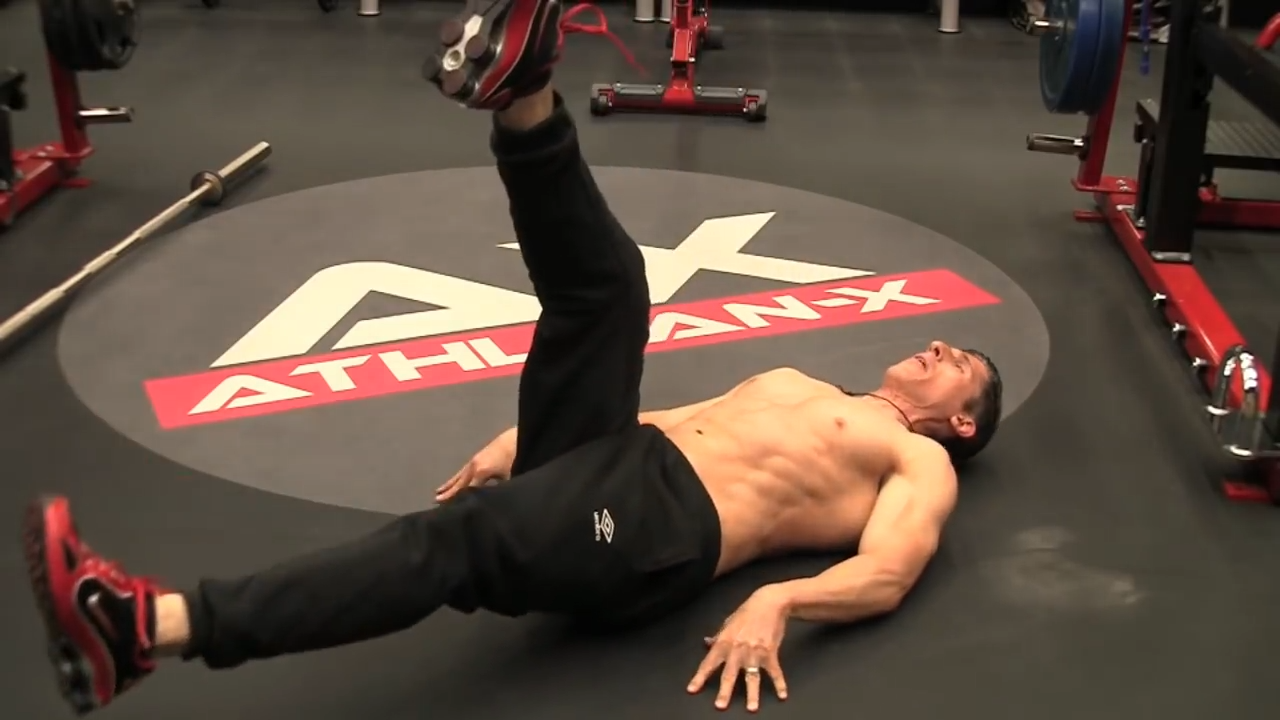
HOW TO DO THE ONE UP ONE DOWN:
- Start lying flat on your back, legs extended straight up.
- From here, drive your hips off the floor. This isn’t a Leg Swing. It’s a controlled Reverse Crunch powered by your lower abs.
- At the top, lower one leg down slowly as you bring your hips back to the ground.
- Then reverse it, raise the leg, lift the hips again, and drop the opposite leg.
- Keep the movement tight. No momentum, no flailing. Just clean, focused reps that light up your lower abs and reinforce control.
WHAT MAKES IT EFFECTIVE: This move is brutally effective for the lower abs because it forces them to control both hip lift and leg lowering, two of the most demanding movements for the rectus abdominis especially without help from momentum or the hip flexors.
LOWER ABS: SWIPER

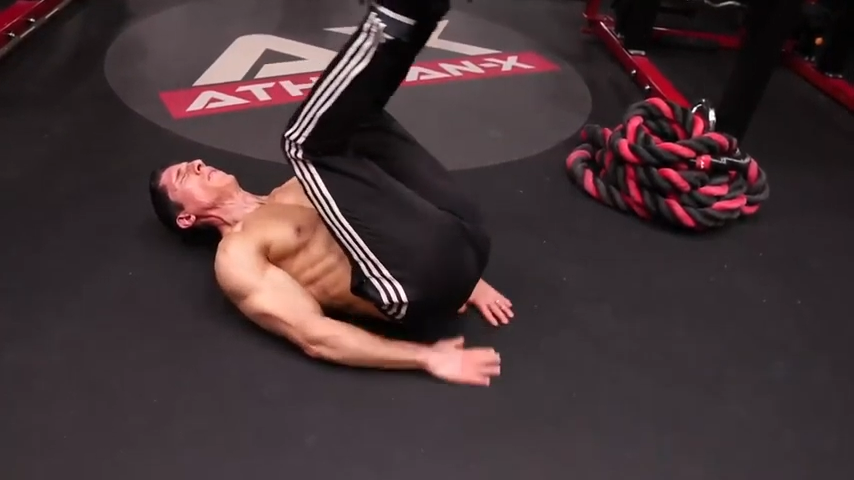
HOW TO DO THE SWIPER:
- Lie back on a mat with your upper body grounded and your legs bent.
- From this starting position, perform a Reverse Crunch by curling your pelvis up and lifting your tailbone off the floor, driving your knees toward your chest.
- As your hips lift, swipe your hands in a half-circle underneath your glutes like you’re trying to catch the tailbone mid-air.
- This does two things: it forces you to lift your hips (not just swing your legs), and it adds an extra layer of core control and precision.
WHAT MAKES IT EFFECTIVE: This isn’t just another reverse crunch—it’s a built-in form check and a lower ab killer in one. You can’t fake the movement. If your tailbone doesn’t leave the mat, your hands won’t get through. That means every rep demands real work from your lower rectus abdominis, not your hip flexors.
BOTTOM UP: REVERSE CRUNCH

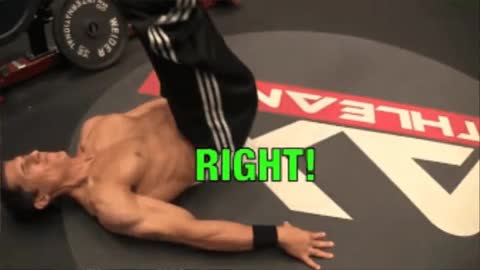
HOW TO DO THE REVERSE CRUNCH:
- Lie flat on your back with your knees bent at a 90-degree angle, calves parallel to the floor.
- Hands go by your sides or tucked under your hips for support (whatever keeps your core tight and your lower back grounded).
- Straighten your legs and lock them in. As you raise them up, don’t just stop at vertical. Lift your hips off the ground using pure lower ab contraction, not momentum.
- At the top, heels should be vertical, pelvis curled, and your transverse abdominis firing like crazy.
- Hold for a beat, make the abs work, don’t just rush the rep.
- Then slowly lower your hips back down. Control the descent. Keep your legs elevated. Don’t rest at the bottom. Keep tension on the abs from start to finish.
WHAT MAKES IT EFFECTIVE: This is an effective bottom-up core exercise because it forces the lower abs to initiate both the leg lift and hip curl, maximizing activation of the rectus abdominis and transverse abdominis without relying on momentum or the hip flexors to do the work.
BOTTOM UP: TWISTING PISTONS

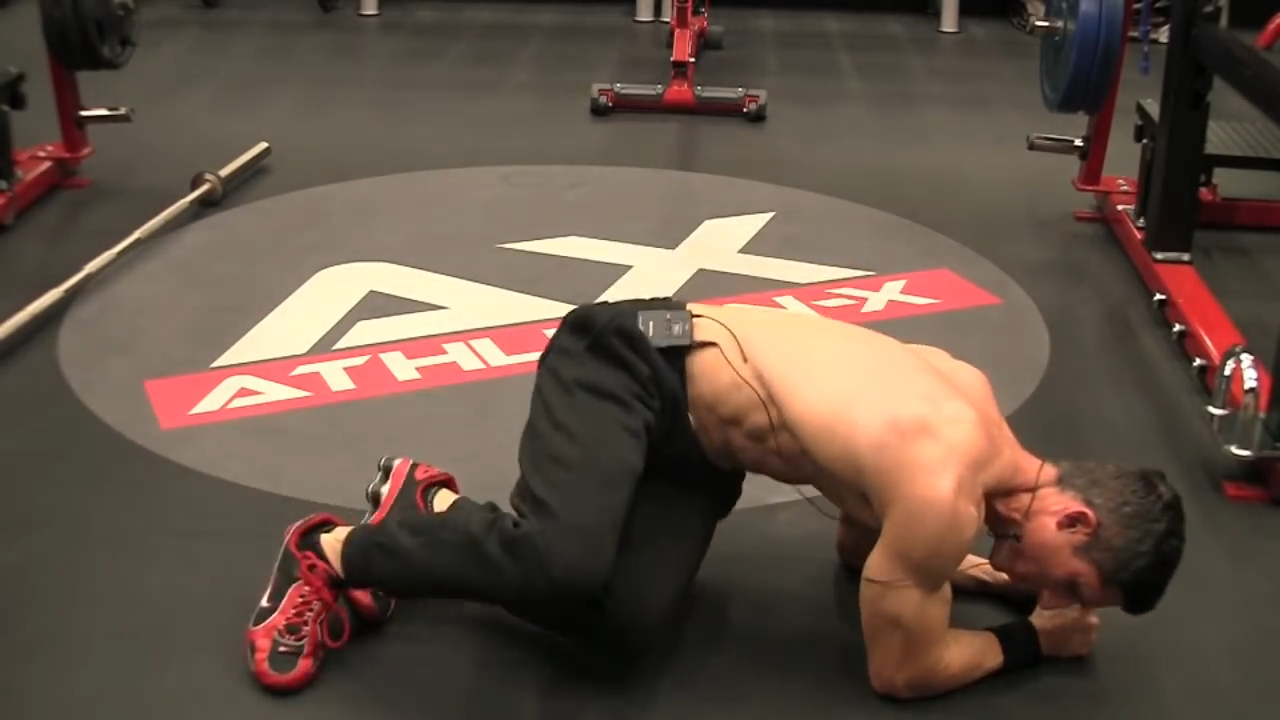
HOW TO DO TWISTING PISTONS:
- Get into a forearm plank position with elbows under shoulders, core tight, and body in a straight line from head to heels. This is your starting position.
- From here, explode both feet in toward your right elbow, keeping your hips low and your abs tight.
- Jump back out to plank, then immediately drive your feet toward your left elbow.
- Keep alternating sides at a fast but controlled pace.
- Don’t let your hips pop up. Stay low, stay tight, and keep your movement crisp.
WHAT MAKES IT EFFECTIVE: This isn’t cardio fluff. It’s a high-intensity core blaster that lights up the obliques, transverse abdominis, and lower abs, all while cranking up your heart rate and metabolic output.
OBLIQUES: side plank (thread the needle)

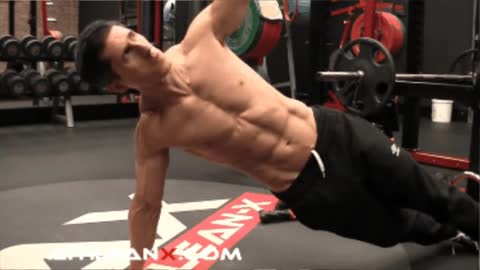
HOW TO DO THE SIDE PLANK (THREAD THE NEEDLE):
- Set up in a Classic Side Plank on your left elbow, stacked under your shoulder, with your hips off the floor and your feet staggered. Lock in your body from head to toe in a straight line with no sagging.
- Now brace your entire core. Your job is to keep your hips level and locked in as you move.
- With control, rotate your torso and thread your right arm under your body.
- Keep the rotation coming from your upper body only. Your legs stay static, and your hips stay high.
- Then reverse the motion, rotating back to the start and reaching your right arm to the ceiling. That’s one rep.
WHAT MAKES IT EFFECTIVE: This isn’t just a Side Plank. It’s a rotational core challenge. You’re hammering the internal and external obliques while demanding total-body stability. Add in shoulder and tricep activation, and you’ve got a full-core assault that builds control, strength, and serious anti-rotation power.
OBLIQUES: PHYSIOBALL PLATE TWIST

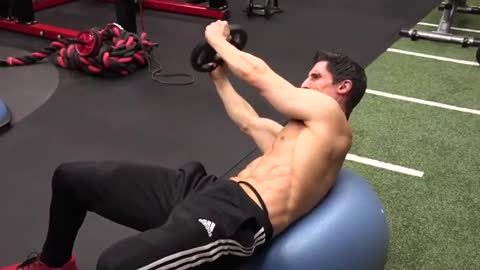
HOW TO DO PHYSIOBALL PLATE TWIST:
- Start with your feet shoulder-width apart. You can go wider if you need a stronger base.
- Keep your feet flat, your core tight, and your glutes engaged.
- Hold a weight plate at chest level, then press it overhead.
- From here, drop the plate down to one side, keeping the top arm straight if possible.
- As the plate moves further from your center, you’ll feel your core muscles light up. This is where the anti-rotation battle begins.
- Don’t rush it. Fight the urge to twist. Control the rotation as you bring the plate back to center, then rotate to the opposite side.
WHAT MAKES IT EFFECTIVE: This exercise forces your core, especially the internal and external obliques, to resist unwanted rotation, building real-world strength, stability, and control through anti-rotational tension, not momentum.
MID-RANGE: HANDS FREE TUCKS

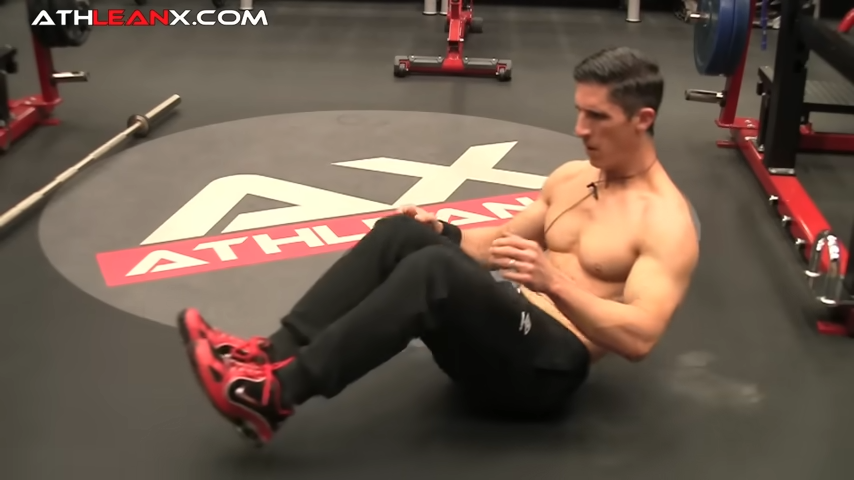
HOW TO DO HANDS FREE TUCKS:
- Start in a solid V-sit position with legs extended, torso upright, and your core braced like you’re about to take a punch.
- From here, lower your torso and legs at the same time, extending outward into a fully opened position. Don’t let your back arch or your legs touch the floor.
- Then, snap it back in. Raise your torso and legs together, meeting at the top like a jackknife. That’s one rep.
WHAT MAKES IT EFFECTIVE: This hits your rectus abdominis, hip flexors, and transverse abdominis all at once. It’s a full-range movement that keeps your entire core musculature under tension and there’s nowhere for weaknesses to hide.


MID-RANGE: LEVITATION CRUNCH
HOW TO DO THE LEVITATION CRUNCH:
- Lie on your back in a basic crunch position: feet flat, hip-width apart, knees bent, and core braced.
- Place your hands lightly behind your head, but don’t use them to yank yourself up. This isn’t about your neck; it’s about your abs doing the work.
- Lift your head and shoulder blades just a few inches off the floor in a controlled curling motion.
- Think about levitating your chest toward the ceiling, not rocking forward. Keep your neck relaxed, elbows open, and let your shoulder blades guide the movement.
- Hold at the top for a beat, keep the core tight, and lower back down under control. That’s one rep.
WHAT MAKES IT EFFECTIVE: This is a targeted upper ab burner. It’s not a big movement, but a brutally effective one. No momentum, no neck cranking, no fancy equipment. Just pure rectus abdominis activation that isolates the upper abs with precision.
TOP-DOWN ROTATION: STARFISH CRUNCH


HOW TO DO THE STARFISH CRUNCH:
- Lie flat on your back in a full “starfish” position with your arms and legs extended wide, core braced, and ready to move.
- First, raise your legs off the floor. This instantly locks your lower abs into position.
- From here, fire up the core and rotate your torso, reaching your left hand toward your right foot in one powerful, diagonal crunch.
- Lower under control, reset, then hit the other side with right hand to left foot.
- Keep alternating, keeping your legs elevated the entire time to maintain constant core tension.
WHAT MAKES IT EFFECTIVE: This is full-body core rotation with zero momentum. You’re hitting your obliques, rectus abdominis, and transverse abdominis in one move while training anti-extension and rotational control.
TOP-DOWN ROTATION: LANDMINE ROTATION

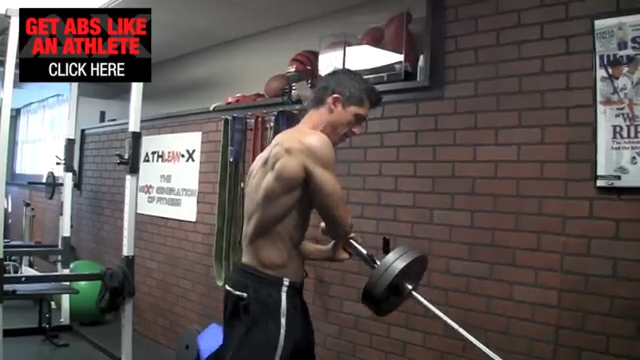
HOW TO DO THE LANDMINE ROTATION:
- Anchor one end of a barbell in a landmine unit or a secure corner.
- Grab the other end with both hands, arms extended in front of your chest. Feet shoulder-width apart, knees soft, core locked in like you’re bracing for a hit.
- Rotate the barbell to one side, letting your torso and shoulders follow but your hips stay square, your legs stay grounded.
- The rotation comes from the core, not the spine. Keep your elbows slightly bent but firm.
- Once you hit the bottom of the arc, drive the bar back across to the other side in one smooth, controlled, explosive twist. Keep the bar path tight and the tension constant.
WHAT MAKES IT EFFECTIVE: Landmine Rotations train top-down rotation, oblique control, and rotational core power without sacrificing stability. You’re building real-world strength for everything from throwing punches to swinging bats and doing it without compromising form.
TOP-DOWN MOVEMENTS: 90-90 CRUNCH
HOW TO DO THE 90-90 CRUNCH:
- Lie flat on your back with your knees bent to 90 degrees, thighs vertical, calves parallel to the floor.
- Lock in that position. This reduces hip flexor recruitment and puts the tension where it belongs: on your upper abs.
- From here, crunch up with a small, controlled movement, lifting your shoulder blades off the floor as you drive your ribs toward your knees.
- Keep your lower back pressed into the ground and your core tight. No neck yanking. No momentum.
WHAT MAKES IT EFFECTIVE: The 90-90 Crunch isolates the rectus abdominis by locking your legs in place and removing compensation from the hips. That means more core activation, less cheating, and better results.
TOP-DOWN MOVEMENTS: CABLE CRUNCH PULLDOWNS

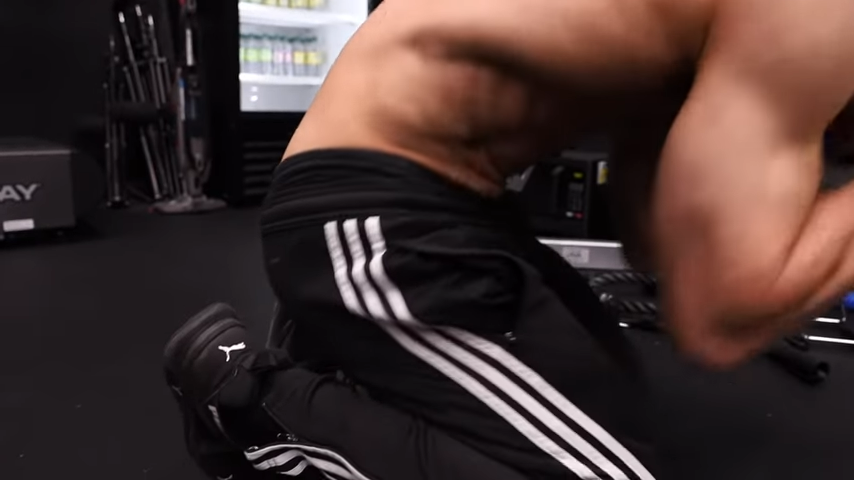
HOW TO DO CABLE CRUNCH PULLDOWNS:
- Get into a kneeling position in front of a high pulley with a rope attachment. Grab the rope and lock your hands by your ears or just above your shoulders. Don’t pull with your arms.
- Now here’s where everyone messes it up: they sit back onto their heels, turning the entire thing into a hip flexion drill and completely taking the rectus abdominis out of the movement.
- Your starting position is your ending position and your hips stay locked in place the whole time.
- From here, initiate the movement by curling your spine down, one vertebra at a time, like you’re folding your chest toward your knees. This is lumbar flexion, and it’s what actually trains your abs.
- Pull your elbows toward the floor, crunch through the spine, squeeze the abs hard, and then reverse it under control.
WHAT MAKES IT EFFECTIVE: When done right, the Cable Crunch Pulldown isolates the rectus abdominis and forces it to work under constant tension. It’s not about how much weight you move. It’s about how much tension you can create. Focus on the quality of the contraction and leave your ego at the door.
AB EXERCISES COMMON MISTAKES
You can know every single ab exercise in the book. You can even follow the Six-Pack Progression to the letter but if you’re making these common mistakes, you’re killing your progress before it starts.
It’s not just about what you do. It’s how you do it. Form, control, and strategy matter more than reps, burn, or how sweaty you get.
Here’s where most fitness enthusiasts, weekend warriors, and even some fitness pros go off the rails.
USING MOMENTUM INSTEAD OF CONTROL
If your crunch looks more like a rocking chair than a core contraction, you’re doing it wrong. Swinging your body doesn’t train the rectus abdominis. It cheats it.
Want to hit your abs muscles hard? Keep your feet flat, control the movement, and squeeze from the abs, not your hip flexors.
It’s all about intensity here. Go slow, feel every movement, and contract the target muscle.
NEGLECTING LOWER ABS AND OBLIQUES
Crunches hit your upper abs but if that’s all you do, your core musculature is imbalanced, and your training is incomplete.
To build a fit appearance and functional strength, you need to target your lower abs and your obliques.
These additional core muscles contribute to both performance and the aesthetic focus you’re after.
SKIPPING PROGRESSIVE OVERLOAD
Doing hundreds of reps of the same ab exercise at the same intensity day after day won’t give you a six-pack.
Why? Because just like the larger muscle groups, your core muscles need variety and new challenges.
If you’re not increasing resistance, slowing tempo, or progressing to more difficult core exercises, your abs have no reason to grow or become more defined.
You’re not training. You’re just going through the motions. Be sure to tap into the principles of progressive overload during all of your workouts.
IGNORING ANTI-ROTATION AND STABILITY WORK
Abs aren’t just for flexion. They stabilize, resist motion, and protect your spine.
Add anti-rotation and stability-based exercises like Pallof Presses, Plank variations, and Single-Arm Carries into your core routines to build durability, not just definition.
These movements train your deeper core muscles to fire when it matters most: under load, under fatigue, and under pressure.
TRAINING ABS WITHOUT ADDRESSING BODY FAT
You can have the abs of people on magazine covers hiding under a layer of belly fat and you’ll never see them.
If your body fat levels aren’t in check, no amount of abs workouts will matter.
The benefit of body transformation comes from combining effective training with a healthy, whole-foods diet, proper dietary intake, and weight maintenance strategies.
That means lean proteins, brown rice, leafy greens, and skipping the latest diet fad in favor of something that actually works.
Speaking of levels of body fat and nutrition…
FAT LOSS IS NON-NEGOTIABLE
You can have the strongest abs on the planet, but if they’re buried under a layer of belly fat, no one’s ever going to see them including you.
This isn’t a genetics issue. It’s a body fat issue. And unless you deal with it head-on, all the abs exercises in your go-to core routine won’t make a difference.
Let’s kick things off by addressing one of the most common fitness myths.
SPOT REDUCTION IS A LIE
Let’s kill the myth once and for all: you can’t burn fat from one specific area of your body no matter how many Crunches, Leg Raises, or abs exercises you do.
Your body doesn’t work that way.
Your body stores fat based on genetic factors, hormone levels, and lifestyle habits.
Where you gain it first, you’ll usually lose it last. Fat loss doesn’t happen where you train. It happens where your body decides to pull from as a fuel source.
So, if you’re training your core like a madman but ignoring your resistance training workout routine, dietary intake, and cardio workouts, you’re not going to see progress.
You’ll build strong abs under the fat but no chiseled midsection to show for it.
THE BODY FAT PERCENTAGE THAT REVEALS ABS
Want to make your aesthetic fitness goals come true by showing off that hard-earned six pack?
For most men, visible six pack abs start to appear around 10–12% body fat. The body fat for women, that range is closer to 16–19%, depending on hormonal balance, calorie and protein intake in women, and overall health concern considerations.
That means if you’re carrying excess weight, even the best core strength training program won’t get you to that distinct appearance.
The matter of body fat has to be addressed through smarter eating, smarter training, and consistent execution.
TRAIN SMART, NOT JUST HARD
You’ve got your body fat percentage goal locked in. You’ve got the best abs exercises in the order you should do them. You’re all set, right? Wrong.
Want to drop fat and crank up your metabolic rate? You can’t just hammer away at abs and hope for the best.
Abs workouts alone won’t get the job done, not if your goal is a lean, defined midsection.
Real fat loss requires total-body strength training and conditioning that drives results.
That means combining functional movements with compound lifts, aiming for the largest muscle groups that elevate heart rate and improve energy expenditure the most.
These multi-joint exercises burn more calories, build lean muscle mass, and reinforce the same core musculature you’re trying to sculpt.
And the more lean muscle mass you have, the better your body gets at burning fat.
You’ll also want to layer in some cardio workouts. Not endless treadmill time but structured sessions like HIIT, sprints, or loaded carries in the frontal plane that keep intensity high and rest between sets low (0-15 seconds).
This is how you burn excess fuel, tap into stored fat, and drive fat reduction across your entire body.
The best approach? Pair an 8-week core training program with a comprehensive workout split built around consistency, progressive overload, and recovery.
You can start with something like this:
Strength Training Days (3–4x/week):
- Focus on compound lifts like Barbell Squats, Deadlifts, and Push Presses.
- Prioritize large muscle groups to build lean muscle mass and drive energy expenditure.
Aerobic/Metabolic Conditioning (2–3x/week):
- Alternate between HIIT, sprint intervals, or circuit-style bodyweight workouts.
- Keep rest between sets tight (0–15 seconds) to maximize fat-burning potential.
Core-Specific Sessions (2–3x/week):
- Use the Six-Pack Progression, starting with bottom-up movements and finishing with top-down for max fatigue and activation.
- Include anti-rotation and stability training to round out your core musculature.
This strategy does more than just burn calories. It builds a lean, athletic physique. You’ll boost energy levels, reduce body fat levels, and improve overall body composition over time.
Plus, total-body training reinforces the benefits of core training by teaching your abs to function as stabilizers during real, functional movements.
Forget chasing the burn with isolated crunches. Start building a training routine that balances strength, conditioning, and core development, and you’ll finally start seeing the abs you’ve been working for.
NUTRITION FOR SIX-PACK ABS
You’ve got the first half of the six-pack equation. Now, let’s talk about arguably the most important piece of the puzzle: nutrition.
You can follow the most advanced comprehensive core training plan and dial in your goals for core training but if your nutrition sucks, your abs will stay buried under a layer of fat storage.
Visible abs aren’t just about the number of exercises per workout or how strong your deep muscle bellies are. They’re about body fat, and nothing impacts your body fat percentages more than what’s on your plate.
The fitness industry has you chasing lifestyle strategies like detox teas, carb-cycling fads, and intermittent fasting schedules that ignore the basics.
Real fat loss doesn’t come from trendy gimmicks. It comes from building healthy lifestyle habits, fueling with fresh foods, and creating consistency.
Because when it comes to abs, it’s not about how many crunches you do. It’s about how many times you choose a healthy diet over a bad diet. That’s the real difference between fit people and frustrated ones.
AVOID SHORTCUTS
There are no shortcuts to a six-pack. No cleanse, no celebrity-endorsed juice plan, and no TikTok trend is going to outwork a healthy, whole-foods diet done consistently.
Diet fads promise speed, but they deliver disappointment.
You might get the initial quick fat reduction, but this will be followed by even faster fat gains once your willpower burns out and your body rebels.
These diets can spike your stress levels, have negative effects on ghrelin and insulin, and elevate cortisol, your body’s primary stress hormone. This will make fat loss harder and rebound weight gain more likely.
And don’t get me started on these so-called “miracle pills” for fat loss. Complete waste of money.
Let’s talk about what really works with these core nutrition principles:
CALORIC DEFICIT
You’ve heard it before because it’s true: you need to burn more than you consume. This is the basic anatomy of fat loss.
It doesn’t matter how many traditional planks, additional push-ups, or lunge position holds you crush. If you’re eating in a surplus, you’re not burning fat. You’re building fat accumulation, not abs.
To get into a caloric deficit, you need to create a gap between what your body burns during regular exercise, movement, and recovery and what you take in from food.
That means training smart, eating smart, and eliminating the idea that you can “out-crunch” a poor diet.
Even small changes matter:
- Increase your activity level with aerobic exercise and full-body forms of exercise
- Keep rest between sets short (decrease rest) to elevate heart rate and maximize fat burn
- Prioritize low-glycemic foods, adequate protein intake, and fuel from food that supports performance
Track your dietary intake, move more during your spare time, and stay consistent with session time.
Even 5-10 min bursts of movement such as walks, mobility drills, and active recovery can tilt the scale in your favor over time.
The goal isn’t starvation. It’s real nutrition paired with effective workouts. That’s how you reach and maintain healthy body fat percentages, improve glycogen levels, support healthy digestion, and get the biggest benefits from your training.
PROTEIN INTAKE
Extra protein isn’t optional. It’s the backbone of any effective fat-loss plan and the key to carving out the kind of lean muscle that makes your abs visible.
You need it to build and preserve lean muscle mass while dropping fat.
Without enough protein on an ongoing basis, your body won’t just burn fat, it’ll burn muscle tissue, especially if you’re training hard and eating in a calorie-restricted diet in the long term. That’s the opposite of what you want.
Question is: how much protein do you need to support fat burning and muscle retention?
The bare minimum is 0.8 grams per pound of bodyweight. This helps maintain muscle if you’re not training intensely. It’s best for people who are sedentary, lightly active, or doing basic aerobic exercise without resistance training.
If you’re lifting regularly and trying to get leaner while maintaining (or building) muscle, aim for 1.0 grams per pound of bodyweight. This is best for anyone training 3-5 times per week, trying to burn fat and reveal a six-pack.
The final level of 1.2 grams per pound of bodyweight is for high-volume, high-intensity training when recovery and muscle retention are critical. This is best for advanced lifters, athletes, or anyone training 6+ days per week, or cutting hard.
If you’re serious about getting shredded, you better get serious about your protein. Here’s what should be showing up on your plate:
Animal-Based: Lean cuts of chicken, turkey, grass-fed beef, whole eggs, Greek yogurt, and cottage cheese—high in quality, easy to prep, and built for recovery.
Plant-Based: Tempeh, lentils, black beans, edamame, and chia seeds—all packed with nutrients and fiber to keep you full and fueled.
Supplements: Supplements don’t replace real food. They complement it. When life gets hectic and you’re short on time, a high-quality whey protein powder can help you hit your daily protein target without the junk.
LOW-GLYCEMIC, HIGH-FIBER FOODS
Cravings. Energy crashes. Constant hunger. Sound familiar? Then this is your fix.
If you’re trying to burn fat, get lean, and build a body that performs as good as it looks, you need fuel from food that works with your body. That’s where low-glycemic, high-fiber carbs come in.
Think: leafy greens, brown rice, sweet potatoes, oats, berries, cruciferous veggies.
These are slow-digesting carbs that deliver clean, sustained energy, support healthy digestion, and help you power through aerobic exercise, endurance tasks, or whatever workout your plan throws at you.
These foods help regulate blood sugar and insulin, keeping you steady instead of riding the crash-and-binge rollercoaster.
THE 40/40/20 RULE (PLATE METHOD)
Here’s the simplest way to structure your meals to burn fat, fuel performance, and finally see your abs.
Take your plate. Mentally divide it into three sections: 40/40/20. Here’s how it works:
40% Protein: This is your recovery fuel and the cornerstone of fat loss without losing muscle. It helps preserve lean muscle mass, speeds up post-workout repair, and keeps you full so you don’t reach for junk an hour later.
40% Fibrous Carbs: This is your volume and nutrient powerhouse. Think of this section as the food that keeps your body performing and your digestion clean because bloating and poor gut health will make your abs look soft, even when your body fat is low. Some examples include spinach, kale, broccoli, carrots, zucchini, berries, apples, oranges, and grapefruit.
20% Starchy Carbs: This is your training fuel. Clean, slow-burning energy to support your session time, boost glycogen levels, and give you the future energy you need to train hard again tomorrow. Some choices include sweet potatoes, quinoa, brown rice, squash, and oats.
You might be wondering where dietary fats fit into this equation. No need to micromanage here.
Healthy fats should be incidental like when it’s used for cooking or built into the food you’re already eating. Think of olive oil, avocados, nuts, seeds, and fatty fish such as salmon.
Fats play a key role in hormonal health, joint function, and satiety but they’re dense in calories. Let them fill in the gaps, not dominate your plate.
HOW TO GET SIX PACK ABS MYTHS
Tired of spinning your wheels trying to get a six-pack? You might be falling for the same myths that keep most people stuck.
Let’s shut down the B.S., clear out the noise, and get you training and eating with a plan that works.
DOING MORE CRUNCHES GETS YOU ABS
You can crunch until your spine folds like an origami swan. But if your body fat percentage is too high, your abs will never show.
Abs are revealed in the kitchen, not through endless reps on the floor.
Crunches strengthen the rectus abdominis, sure, but if you’re not following healthy strategies to reduce fat and dial in nutrition, all you’re building is muscle under fat.
Real abs come from training your entire body, improving your energy source efficiency, and dialing in lifestyle factors like sleep, stress, and a healthy diet.
FAT BURNERS WILL MELT BELLY FAT
There is no supplement that will outwork poor habits. Fat burners don’t “melt” anything. They stimulate your central nervous system, increase heart rate, and may reduce appetite.
But without a caloric deficit, all they do is drain your wallet and raise your stress levels, which can ironically make fat loss harder through elevated cortisol.
The real fat-burners?
You can get improved outcomes through strength training, conditioning, proper sleep, and wiser food choices.
Don’t forget a diet rich in nutrient-dense foods, hydration (yes, hit your daily H2O goals), and gains over time, not overnight.
KETO IS THE ONLY WAY TO GET SHREDDED
Keto works… for some people. But it’s not the only path to fat loss, and it’s definitely not a shortcut.
What actually works? The diet you can sustain. The one that fits your current fitness level, your schedule, and your lived experience.
The fat loss benefits of low-carb eating are real, but so are the risks of doing it wrong.
Cut carbs too hard, and you lose out on a key energy source for high-performance training.
Focus on consistency instead of extremes.
ABS ARE GENETIC
This one’s tricky because it’s partially true. Genetics influence the shape of your abs, how fat is stored, and how deep your abdominal separation looks.
But whether you have visible abs? That’s entirely trainable.
Through healthy strategies, an effective training plan, and consistent nutrition, you can absolutely build a core that performs and looks like the epitome of fitness even if you weren’t born with perfect 8-pack genes.
PUTTING IT ALL TOGETHER
So, now you’ve got the exercises. You’ve got the nutrition. But the question is, how do you make it all work together?
That’s where most people fall apart. They hit random ab circuits without a plan and wonder why their results plateau.
To get lean, defined abs and improved health across the board, you need a structured weekly approach that targets every plane of motion, hits every layer of your core musculature, and lines up with your common goal: visible, functional abs that show up and hold up.
Here are some six-pack workouts you can start using today along with an example meal plan to follow based on the guidelines above.
SIX-PACK WORKOUT A
| CATEGORY | EXERCISE | SETS | REPS |
| Lower Abs | One Up, One Down | 3 | 10–12/side |
| Bottom-Up | Reverse Crunch | 3 | 12–15 |
| Obliques | Side Plank (Thread the Needle) | 3 | 10/side |
| Mid-Range | Levitation Crunch | 3 | 15–20 |
| Top-Down Rotation | Landmine Rotation | 3 | 8–10/side |
| Top-Down | 90-90 Crunch | 3 | 12–15 |
SIX-PACK WORKOUT B
| CATEGORY | EXERCISE | SETS | REPS |
| Lower Abs | Swiper | 3 | Swiper |
| Bottom-Up | Twisting Pistons | 3 | 30 sec |
| Obliques | Physio Ball Plate Twist | 3 | 12–15/side |
| Mid-Range | Hands-Free Tucks | 3 | 15–20 |
| Top-Down Rotation | Starfish Crunch | 3 | 12/side |
| Top-Down | Cable Crunch Pulldown | 3 | 12–15 (moderate weight) |
SAMPLE MEAL PLAN
Here’s a single day of an abs-friendly meal plan based on what I covered above. For reference, this sample plan is based on someone who weighs 180 pounds.
You can easily tweak this meal plan to fit your macronutrient needs based on your own weight.
This should give you a good idea of what a typical day will look like when you’re going after a six pack.
MEAL 1 – BREAKFAST
- 4 whole egg whites + 2 whole eggs
- ½ cup black beans
- 1 cup spinach (cooked in olive oil)
- 1 small apple
MEAL 2 – LUNCH
- 6 oz grilled chicken
- 1 cup steamed broccoli
- ½ cup cooked quinoa
- ¼ avocado
- Squeeze of lemon + olive oil drizzle
MEAL 3 – PRE-WORKOUT SNACK
- Protein shake with banana
MEAL 4 – DINNER
- 6 oz grilled or baked salmon
- 1 small sweet potato (roasted)
- 1–2 cups mixed greens (kale, arugula, romaine)
- Olive oil + apple cider vinegar dressing
OPTIONAL MEAL 5 – EVENING SNACK
- 1 cup plain, nonfat Greek yogurt
- ½ cup blueberries
- Sprinkle of chia seeds
Most people think getting a six-pack is about doing more. More crunches, more cardio, more sacrifice.
But the truth is, it’s about doing the right things in the right order over and over again.
Train with a strategy, eat with precision, and stop letting myths, fads, or frustration steal your progress.
Don’t have a game plan or need something more substantial than the example workouts above? I’ve got you covered.
Our 6 Pack Shuffle workout creator app is available with all of our ATHLEAN-X Training Programs. Get yours now (along with your day by day nutrition and workout plans) and get a ripped six pack while building athletic muscle from head to toe in just 90 days.
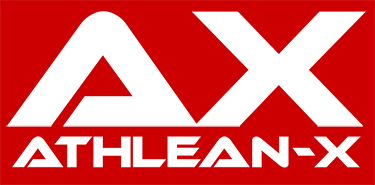
- You need two things to get six-pack abs: the right ab exercise progression (not random circuits) and a proven fat-loss strategy to lower body fat percentages.
- Follow the Six-Pack Progression for max results. Do your six-pack exercises in the following order: lower abs, bottom-up, obliques, mid-range, top-down rotation, and top-down.
- Remember that body fat percentage matters more than crunches. For men, visible abs appear at 10–12% body fat. For women, abs start to show around 16–19%
- An effective fat loss strategy revolves around nutrition. You should eat in a caloric deficit or burn more than you consume.
- Hit 1 gram of protein per pound of bodyweight to build and preserve lean muscle while supporting fat loss.
- Plan your meals on the 40/40/20 rule: 40% Protein, 40% Fibrous Carbs (vegetables & fruits), and 20% Starchy Carbs (quinoa, sweet potatoes, brown rice)
- Consistency beats intensity. You don’t need perfect workouts or flawless meals. You need repeated effort over time.
SIX PACK ABS FAQ
It depends on one thing: your starting body fat percentage. If you're already close to the healthy average (around 10–12% for men, 16–19% for women), and you dial in your training and nutrition, it could take a few weeks.
But if you're carrying excess fat, it could take several months. Not because you’re lazy, but because fat loss happens gradually, not on a 30-day countdown clock.
Forget the calendar. Focus on consistency, and the results will come. Every rep, every clean meal, and every good decision gets you one step closer.
You don’t get six-pack abs fast. You get them by doing the right things consistently. If you're chasing speed, you're already looking in the wrong direction.
Focus on dropping body fat through a smart training split (full-body lifting + conditioning), lock in your nutrition, and follow a core progression that hits every angle.
Abs don’t come from shortcuts. They come from strategy, discipline, and showing up harder and smarter than everyone else who wants them just as bad.
If you’re already lean and just need to tighten things up, then maybe. But if you’ve got 15 to 20 pounds of fat to lose? Not a chance.
Your body has to reach a normal range of body fat for abs to be visible and your six-pack doesn’t care about your deadline.
Trying to force it with crash diets or extreme routines only leads to increased rates of burnout, rebound weight gain, and injuries.
Be consistent with your training and nutrition and the results will come.
It can be if you earn it the right way. Abs that come from disciplined eating, strength training, and functional movements reflect strong habits and a resilient body.
But chasing shredded abs through starvation or overtraining? That’s where things can go south fast.
The healthiest six-packs come with strength, performance, and balanced lifestyle habits, not just aesthetics.
When done right, they’re more than a look. They’re a reflection of control, power, and low rates of obesity, not obsession.
REFERENCES
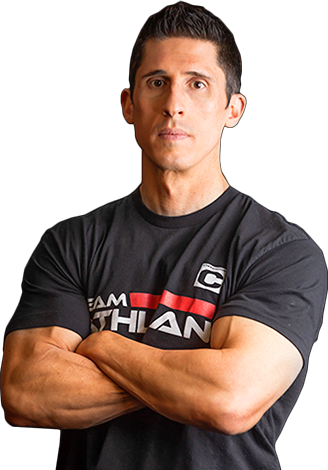
Jeff Cavaliere M.S.P.T, CSCS
Jeff Cavaliere is a Physical Therapist, Strength Coach and creator of the ATHLEAN-X Training Programs and ATHLEAN-Rx Supplements. He has a Masters in Physical Therapy (MSPT) and has worked as Head Physical Therapist for the New York Mets, as well as training many elite professional athletes in Major League Baseball, NFL, MMA and professional wrestling. His programs produce “next level” achievements in muscle size, strength and performance for professional athletes and anyone looking to build a muscular athletic physique.
